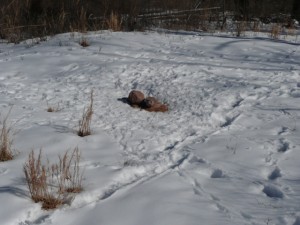Hunt Mature Bucks with a Predictable Pattern
Filed under: Deer Hunting, Hunting Blog
The second chase phase (the period of the rut after the lock down phase) is on or winding down in most parts of the whitetails’ range (excluding parts of Alabama, Florida, south Texas, etc.). This means a small percentage of adult does haven’t bred yet, and most of the yearling female fawns haven’t bred yet.
Bucks will be moving more searching for receptive does and for quality food resources. Likewise, does will begin moving a bit more as the intensity of the rut decreases as both does and bucks are seeking sources of quality food.

Deer tracks in snow near a Trophy Rock
The quantity and number of locations with quality food is decreasing with the winter temperatures, unless supplemental feed is used on the property you hunt. Therefore identifying the preferred feeding location for deer is becoming easier. That’s great news for hunters!
However, it doesn’t mean hunting is becoming easier. Hunting season has been in effect throughout most of the whitetails’ range for several months. Mature deer are very conditioned to avoiding hunters at this stage of the season. Therefore, identifying the preferred food source is only part of challenge.
Chasing deer that are experienced at avoiding hunters is no easy task. The leaves are mostly off hardwood trees so stands that offered great cover a month ago now leave the hunter wide open.
Good camo, especially on the face and hands (the parts of a hunter that move the most when they are in a stand) is a must. Remember that deer see movement much better than they see cover.
Deer may be conditioned to avoid some fields during daylight due to the amount of hunting in that location already during the season. If that’s the case, select a stand location between the bedding area and the field. Better yet, if practical avoid hunting some plots until the late season. Let deer become conditioned to feeding in an area without being disturbed by hunters. Those are dream locations during the late season. I often use an electric fence to protect small plots until the late season. These plots would have been totally consumed if not protected by the fence.
Finally, with the colder the temperatures, the more deer need to feed to maintain their body temperature. Colder temperatures usually result in deer feeding during daylight hours. Mature bucks will be feeding in the plots that haven’t had much hunting pressure and I plan on being there. The late season usually offers some of the most predictable deer activity throughout the entire season.
I ordered some heated insoles for my boots today. I’m hoping for some very cold days during the late hunting season. It’s worth getting a little cold to hunt mature bucks that have a predictable movement pattern to specific location.
Growing Deer together,
Grant



